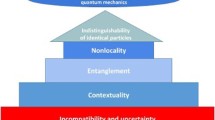Abstract
In the foundations of quantum mechanics Gleason’s theorem dictates the uniqueness of the state transition probability via the inner product of the corresponding state vectors in Hilbert space, independent of which measurement context induces this transition. We argue that the state transition probability should not be regarded as a secondary concept which can be derived from the structure on the set of states and properties, but instead should be regarded as a primitive concept for which measurement context is crucial. Accordingly, we adopt an operational approach to quantum mechanics in which a physical entity is defined by the structure of its set of states, set of properties and the possible (measurement) contexts which can be applied to this entity. We put forward some elementary definitions to derive an operational theory from this State–COntext–Property (SCOP) formalism. We show that if the SCOP satisfies a Gleason-like condition, namely that the state transition probability is independent of which measurement context induces the change of state, then the lattice of properties is orthocomplemented, which is one of the ‘quantum axioms’ used in the Piron–Solèr representation theorem for quantum systems. In this sense we obtain a possible physical meaning for the orthocomplementation widely used in quantum structures.
Similar content being viewed by others
References
Jauch, J.M.: Foundations of Quantum Mechanics. Addison–Wesley, Reading (1968)
Piron, C.: Axiomatique quantique. Helv. Phys. Acta 37, 439–468 (1964)
Piron, C.: Foundations of Quantum Physics. Benjamin, Reading (1976)
Aerts, D.: The one and the many: towards a unification of the quantum and the classical description of one and many physical entities. Doctoral dissertation, Vrije Universiteit Brussel (VUB) (1981)
Aerts, D.: Description of many separated physical entities without the paradoxes encountered in quantum mechanics. Found. Phys. 12(12), 1131–1170 (1982)
Aerts, D.: Classical theories and non-classical theories as a special case of a more general theory. J. Math. Phys. 24, 2441–2453 (1983)
Aerts, D.: A possible explanation for the probabilities of quantum mechanics. J. Math. Phys. 27, 202–210 (1986)
Aerts, D.: Quantum axiomatics. In: Engesser, K., Gabbay, D., Lehmann, D. (eds.) Handbook of Quantum Logic and Quantum Structures. Elsevier, Amsterdam (2009)
Solèr, M.P.: Characterization of Hilbert spaces by orthomodular spaces. Commun. Algebra 23, 219–243 (1995)
Aerts, D., Durt, T.: Quantum, classical and intermediate, an illustrative example. Found. Phys. 24, 1353–1369 (1994)
D’Hooghe, B.: On the orthocomplementation of State–Property–Systems of contextual systems. Int. J. Theor. Phys. (2010, accepted)
Gleason, A.M.: Measures on the closed subspaces of a Hilbert space. J. Math. Mech. 6, 885–893 (1957)
Aerts, D.: Being and change: foundations of a realistic operational formalism. In: Aerts, D., Czachor, M., Durt, T. (eds.) Probing the Structure of Quantum Mechanics: Nonlinearity, Nonlocality, Probability and Axiomatics, pp. 71–110. World Scientific, Singapore (2002)
Flender, C.: Ecological modelling of information systems. In: McBrien, P. et al. (eds.) Proceedings of the 15th Doctoral Consortium at CAiSE-2008, vol. 343, pp. 40–52 (2008)
Flender, C., Kitto, K., Bruza, P.: Beyond ontology in information systems. In: Bruza, P. (ed.) Proceedings of the Third Quantum Interaction Symposium (QI 2009). Lecture Notes in Artificial Intelligence, vol. 5494, pp. 289–298. Springer, Berlin (2009)
Aerts, D., Pulmannova, S.: Representation of state property systems. J. Math. Phys. 47, 1–18 (2006)
Aerts, D.: Quantum structures, separated physical entities and probability. Foundations of Physics 24(9), 1227–1259 (1994)
Birkhoff, G.: Lattice Theory. AMS, Providence (1967)
Gisin, N.: Propensities and the state-property structure of classical and quantum systems. J. Math. Phys. 25(7), 2260–2265 (1984)
Gisin, N.: Propensities in a non-deterministic physics. Synthese 89, 287–297 (1991)
Author information
Authors and Affiliations
Corresponding author
Rights and permissions
About this article
Cite this article
D’Hooghe, B. A Possible Operational Motivation for the Orthocomplementation in Quantum Structures. Found Phys 40, 1669–1680 (2010). https://doi.org/10.1007/s10701-010-9464-9
Received:
Accepted:
Published:
Issue Date:
DOI: https://doi.org/10.1007/s10701-010-9464-9




